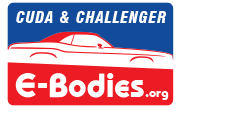- Welcome to E-Bodies.org Cuda Challenger Forum.
1970 Barracuda Reanimated.
Started by Marty, December 13, 2020, 04:02:31 AM
Previous topic Next topicmtull and 5 Guests are viewing this topic.
Tags:
User actions

|
Highest VINs for any 1970 Barracuda/Cuda or 1970 Challenger/RT/SEStarted by MoparCarGuy on VIN, Fender Tag, Build Sheet & Date Codes |
16 Replies
3452 Views |
Last post: May 06, 2024, 07:19:20 PM by cuda hunter |

|
1970 Plymouth Barracuda 1970 Plymouth Cuda 52,000 Miles Barn Find EBAYStarted by mopartaz on Cars For Sale or Wanted |
5 Replies
2026 Views |
Last post: February 07, 2021, 12:02:04 PM by JS29 |

|
1970 barracudaStarted by Moprr on Cars For Sale or Wanted |
5 Replies
1596 Views |
Last post: October 29, 2019, 10:33:07 PM by 6bblgt |

|
1970 Barracuda GC, 383 D21 FC7Started by LoStHeMi on Cars For Sale or Wanted |
2 Replies
955 Views |
Last post: January 26, 2023, 04:22:26 PM by Mr Cuda |

|
1970 Barracuda $19,500Started by Mopsquad on Cars For Sale or Wanted |
4 Replies
1448 Views |
Last post: August 01, 2021, 08:33:20 PM by 340challconvert |



